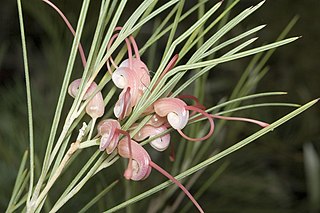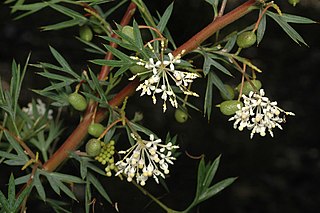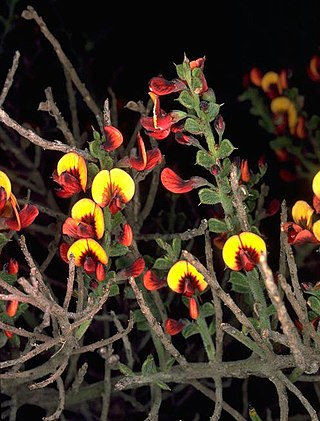
Banksia purdieana is a species of bushy shrub that is endemic to Western Australia. It has broadly linear, pinnatipartite leaves with sharply-pointed lobes on the sides, yellow flowers in heads of about eighty and egg-shaped follicles.

Grevillea excelsior, commonly known as flame grevillea or yellow flame grevillea, is a species of flowering plant in the family Proteaceae and is endemic to the south-west of Western Australia. It is an erect shrub or small tree with usually divided leaves with linear lobes, and clusters of orange flowers.

Grevillea asteriscosa, commonly known as star-leaf grevillea, is a species of flowering plant in the family Proteaceae and is endemic to the south-west of Western Australia. It is a shrub with widely-spreading branches, star-shaped leaves with sharply-pointed lobes, and bright red flowers.

Melaleuca cliffortioides is a plant in the myrtle family, Myrtaceae and is endemic to the south-west of Western Australia. It is a small, prickly shrub very similar to Melaleuca podiocarpa but with fewer stamens in the flowers.

Melaleuca depressa is a plant in the myrtle family, Myrtaceae and is endemic to the south-west of Western Australia. It is a small, bushy shrub with clusters of yellow or cream flowers on the ends of its branches in spring.

Hakea pritzelii is a flowering shrub in the family Proteaceae and is endemic to a few small areas in the Great Southern region of Western Australia. It has rigid, pale green leaves and scented red-purple flowers.
Grevillea eremophila is a species of flowering plant in the family Proteaceae and is endemic to the south-west of Western Australia. It is an erect shrub with leathery, linear to narrowly egg-shaped leaves with the narrower end towards the base, and creamy-white flowers.

Grevillea incrassata is a species of flowering plant in the family Proteaceae and is endemic to inland south-western Western Australia. It is an erect shrub with crowded cylindrical or narrowly linear leaves and clusters of bright yellow flowers.
Grevillea incurva is a species of flowering plant in the family Proteaceae and is endemic to inland south-western Western Australia. It is an erect shrub with linear adult leaves and clusters of creamy-yellow flowers.

Grevillea oncogyne is a species of flowering plant in the family Proteaceae and is endemic to inland areas of Western Australia. It is an erect to spreading shrub with linear, sometimes lobed leaves, and clusters of red or pinkish red flowers.

Grevillea phanerophlebia, commonly known as the prominent vein grevillea and the vein leaf grevillea, is a species of flowering plant in the family Proteaceae and is endemic to a restricted part of the south-west of Western Australia. It is an erect, spreading or straggly shrub with divided leaves, the lobes linear, and white and cream-coloured to yellow flowers.

Grevillea uncinulata, also known as hook-leaf grevillea, is species of flowering plant in the family Proteaceae and is endemic to the south-west of Western Australia. It is an erect, open shrub with linear to elliptic leaves arranged in clusters along the branches, and small clusters of white flowers, the style with a yellow, orange or red tip.

Kunzea montana, commonly known as mountain kunzea, is a flowering plant in the myrtle family, Myrtaceae and is endemic to the south-west of Western Australia. It is a shrub or small tree with more or less round leaves and heads of cream-coloured to pale yellow flowers on the ends of the branches in late spring. It is an uncommon species, growing on rocky mountain slopes, but all populations are conserved in the Stirling Range National Park.
Baeckea grandibracteata is a species of flowering plant in the family Myrtaceae and is endemic to central Western Australia. It is an erect to spreading shrub that typically grows to a height of 0.15 to 0.9 metres and blooms between September and December producing pink and white flowers. Found on undulating sand-plains in the eastern Wheatbelt region of Western Australia in the area around Yilgarn, it grows in sandy and sandy loam soils.
Baeckea grandis is a species of flowering plant in the family Myrtaceae and is endemic to the south-west of Western Australia. It is an ascending to low-lying shrub that typically grows to a height of 0.1 to 0.5 metres and blooms between September and December producing pink and white flowers. Found on sand-plains and hills in the Mid West and northern Wheatbelt regions of Western Australia, it grows in sandy and lateritic soils.
Hakea recurva subsp. arida is a plant in the family Proteaceae endemic to the south-west of Western Australia.

Daviesia dielsii, commonly known as Diels' daviesia, is a species of flowering plant in the family Fabaceae and is endemic to the south-west of Western Australia. It is on intricately-branched shrub with sharply-pointed, egg-shaped, vertically compressed phyllodes, and yellow and red flowers.
Grevillea ceratocarpa is a species of flowering plant in the family Proteaceae and is endemic to inland areas of the south-west of Western Australia. It is an erect or spreading shrub with softly-hairy, narrowly elliptic or narrowly egg-shaped leaves with the narrower end towards the base, and creamy-white flowers.
Lasiopetalum microcardium is a species of flowering plant in the family Malvaceae and is endemic to the south-west of Western Australia. It is a low, spreading or straggling shrub with hairy stems, heart-shaped leaves and blue, purple or white flowers.

Mirbelia depressa is a species of flowering plant in the family Fabaceae and is endemic to Western Australia. It is an erect or spreading, prickly shrub that typically grows to a height of 0.15–1 m high and has yellow or orange and reddish-brown flowers from August to October. It was first formally described in 1904 by Ernst Georg Pritzel in the Botanische Jahrbücher für Systematik, Pflanzengeschichte und Pflanzengeographie. The specific epithet (depressa) means "pressed down", referring to the low habit of this species. This mirbelia grows on sandplains and is widespread in the Avon Wheatbelt, Coolgardie, Esperance Plains, Geraldton Sandplains, Gibson Desert, Great Victoria Desert, Mallee, Murchison and Yalgoo and bioregions of Western Australia, and is listed as "not threatened" by the Government of Western Australia Department of Biodiversity, Conservation and Attractions.















